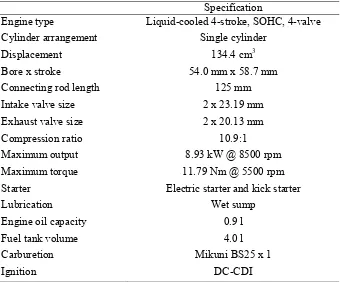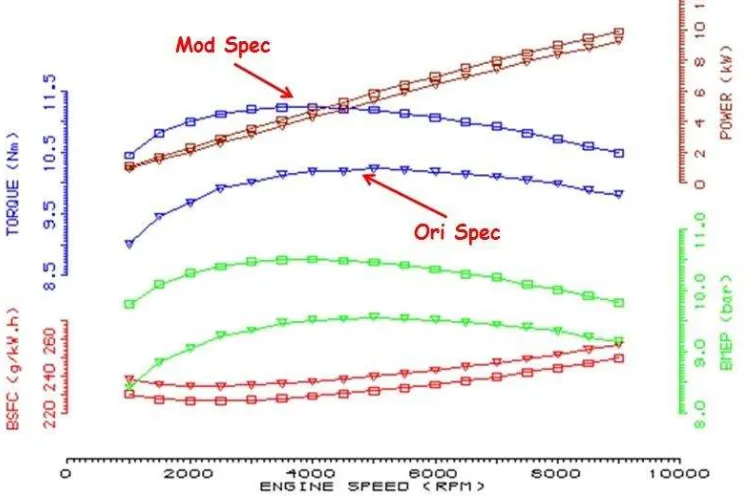Download details:
IP Address: 203.106.159.204
This content was downloaded on 16/12/2013 at 12:17
Please note that terms and conditions apply.
View the table of contents for this issue, or go to the journal homepage for more
Development and modification of a single overhead camshaft
4-valve 4-stroke 135 cc formula varsity race car engine
M A Abdullaha, N Tamaldin, H Rusnandi, T Manoharan and M A Samsir
Centre for Advanced Research in Energy, Faculty of Mechanical Engineering, Universiti Teknikal Malaysia Melaka, Hang Tuah Jaya, 76100, Durian Tunggal, Melaka, Malaysia
E-mail: [email protected]
Abstract.The engine that was chosen to be developed and modified is Yamaha LC 135 Single Overhead Camshaft (SOHC) 4-valve 4-stroke 135cc liquid-cooled engine. The engine selection is based on the specification, rule and regulation in UTeM Formula Varsity 2012 (FV 2012). The engine performance is determined by engine operating characteristics. The engine air flow affects the filtration, intake and exhaust systems. The heat from the engine rejected to the surrounding through the active cooling system which has radiator and fan. The selection of the engine is based on weighted decision matrix which consists of reliability, operating and maintenance cost, fuel consumption and weight. The score of the matrix is formulated based on relative weighted factor among the selections. It been compared between Yamaha LC 135 Single Overhead Camshaft (SOHC) 4-valve 4-stroke 135cc liquid-cooled engine, Honda Wave 125 X Air Cooled, 4 Cycle Engine Overhead Camshaft (OHC) and Suzuki Shogun RR 4 stroke air cooled Single Overhead Camshaft (SOHC). The modification is applied to the engine through the simulation and tuning of Capacitor Discharge Ignition (CDI).
1. Introduction
Bore x stroke 54.0 mm x 58.7 mm
Connecting rod length 125 mm
Intake valve size 2 x 23.19 mm
Exhaust valve size 2 x 20.13 mm
Compression ratio 10.9:1
Maximum output 8.93 kW @ 8500 rpm
Maximum torque 11.79 Nm @ 5500 rpm
Starter Electric starter and kick starter
Lubrication Wet sump
Engine oil capacity 0.9 l
Fuel tank volume 4.0 l
Carburetion Mikuni BS25 x 1
Ignition DC-CDI
2. Methodology
Lotus Single Engine Simulation is used to analyze by changing parameter such as bore size of piston to get the result which can sustain the engine for 30 Laps in Melaka International Motorsport Circuit (MIMC) for 48 km. The analyses of the engine include engine fuel consumption, engine heat rejection, and factor of safety. Through this theoretical proof modification is made on the engine precisely and accurately. The modifications are:
i. Substitution of current Ignition Capacitor Discharge Ignition (CDI) to Capacitor Discharge Ignition (CDI) of Racing Rextor and unlimited Rotation per Minute (RPM).
ii. Engine overhaul and increment of bore size of piston to 57 mm with new connecting rod. iii. Improvement of Carburetor with Throttle Position Sensor (TPS) and accelerator pump to
UMA Racing Carburetor with Throttle Position Sensor (TPS) and accelerator pump (Main Jet size 142 - Pilot Jet size 45).
The modification follows the specification, rule and regulation that been fixed in UTeM Formula Varsity 2012 [9]. The engine is shown in figure 1. Figure 2 shows the software program (capacitor discharge ignition (CDI) of Racing Rextor Tuning Program) used to in the development and modification of the engine for Formula Varsity race car.
Figure 1. Yamaha LC135 engine [10].
Figure 2. Concept design No. 2.
3. Analysis
The Lotus Single Engine simulation program is used to simulate the performance of the engine by 3 basic steps:
i. Construction of simulation model and engine specifications. ii. Data and test conditions are defined for the cycle simulation.
Compression ratio, rc 12.2:1
The engine torque is calculated at max power [14].
P =
60 2 NT
(2)
The average piston speed at max power is [15],
Up= NS (3)
The thermal efficiency is calculated by [14],
Throughout the modification process, the engine components are machined and amended according to the standard procedures of workshop and machining practices [17-21]. The engine trial is performed on the Melaka International Motorsport Circuit (MIMC).Table 3. Results and data of the modified engine.
Engine Specification Value
Engine Capacity 194.78 cc
Engine Torque at maximum Power 29.8235 N.m
Average piston speed@ max power 16.63 ⁄
Bore-Stroke ratio (B/S) 1.1073
Volumetric Efficiency 0.878 @ 87.8%
Engine Power at maximum Torque 26.55 kW @ 35.6 hp
Thermal Efficiency 0.567 @ 56.7%
Fuel flow rate 8.0952 ml/s
Fuel per millage 0.2125 ml/m
4. Results and Discussion
Through the simulation results obtained for original engine condition, the maximum torque is 10.23 Nm @ 5500 rpm and the maximum power is 8.80 kW @ 8,500 rpm. The compression ratio is 10.9 : 1. The comparison of performance summary between the original and modified engine is shown in figure 4. The simulation analysis result for the modification engine has established approving outcome in term of 194.78 cc of engine capacity, compression ratio 12.2:1, bore size of piston 65 mm, engine power at maximum torque 26.55kW @ 35.6hp, engine torque at maximum power 29.8235 Nm, and thermal efficiency of 56.7%. It is validated that the theoretical data calculated and the results are precise. With the modification of the engine, the performance is improved for endurance and racing.
Figure 4. Performance summary comparison of original and modification.
5. Conclusion
Through the research, development and modification of FV race car engine is successfully performed. The parameters such as bore size, stroke length, compression ratio, valve timing give significant impact to the engine performance when modified. The simulation analysis result has established approving outcome in term of engine capacity, compression ratio, engine power at maximum torque, engine torque at maximum power and thermal efficiency. The engine is later assembled with power train and chassis for the FV racing competition. The validation of the results between simulation and theoretical calculation shows the availability and practicality of engine modification.
Acknowledgments
Teknologi MARA, Pulau Pinang Malaysia
[2] Abdul Munir, Munir F, Shaharuzaman M A, Hassan M Z, Mohamad Zin M R, Mohd Azmi, M I
and Mat Nuri N R 2011 Components Design of a Single Seat Educational Race Vehicle, Malaysian Technical Universities International Conference on Engineering & Technology (MUiCET 2011) 13-15 November 2011 UTHM Batu Pahat Johor
[3] Abdullah M A, Mansor M R, Mohd Tahir M, Abdul Kudus S I, Hassan M Z and Ngadiman M
N 2013 Analysis and Fabrication of Chassis Frame for UTeM Formula VarsityTM Race Car International Journal of Mining, Metallurgy & Mechanical Engineering (IJMMME)1 75-77
[4] Abdullah M A, Mansor M R, Mohd Tahir M, Abdul Kudus S I, Hassan, M Z and Ngadiman, M.
N 2012 Analysis and Fabrication of Chassis Frame for UTeM Formula VarsityTM Race Car, Proceeding for International Conference on Manufacturing and Industrial Engineering
(ICMIE’12), International Scientific Academy of Engineering & Technology (ISAET), Kuala Lumpur, Malaysia, (December 29th to 30th, 2012)
[5] SAE, 2012 Formula SAE Competition Rules and Regulations, Society of Automotive
[9] UTeM FV2012 2012 Formula Varsity Competition Rules and Regulations, Universiti Teknikal Malaysia Melaka, Melaka, Malaysia
[14] Pulkrabek WW 1997 Engineering Fundamental of Internal Combustion Engine (Prentice Hall: New Jersey)
[15] Heywood J B 1998 Internal Combustion Engine Fundamental (McGraw Hill: New York) [16] Challengers 101, 2012. Exhaust and Intake Tuning. Retrieved 12 December, 2012, from
http://www.challengers101.com/IntakeTuning.html.
[17] Serope Kalpakjian, Steven Schmid 2006 Manufacturing Engineering and Technology (Canada: Prentice Hall)
[18] Miller R And Richard M 2004 Machine Shop Basics All new (Wiley Publishing, Inc)
[19] W. A. J. Chapman. 2001. Workshop Technology: Part 1, 5(United Kingdom. Edward Arnold Publishers Limited)
[20] Khurmi R S and Gupta J K 2008 Theory of Machines (14th ed.) ( Eurasia Publishing House) p 371
[21] Budynas R and Nisbett K 2006 Shigley’s Mechanical Engineering Design (8th ed.) (McGraw Hill) p 504

![Figure 1. Yamaha LC135 engine [10].](https://thumb-ap.123doks.com/thumbv2/123dok/530624.61337/4.595.72.526.294.614/figure-yamaha-lc-engine.webp)

